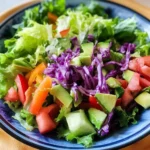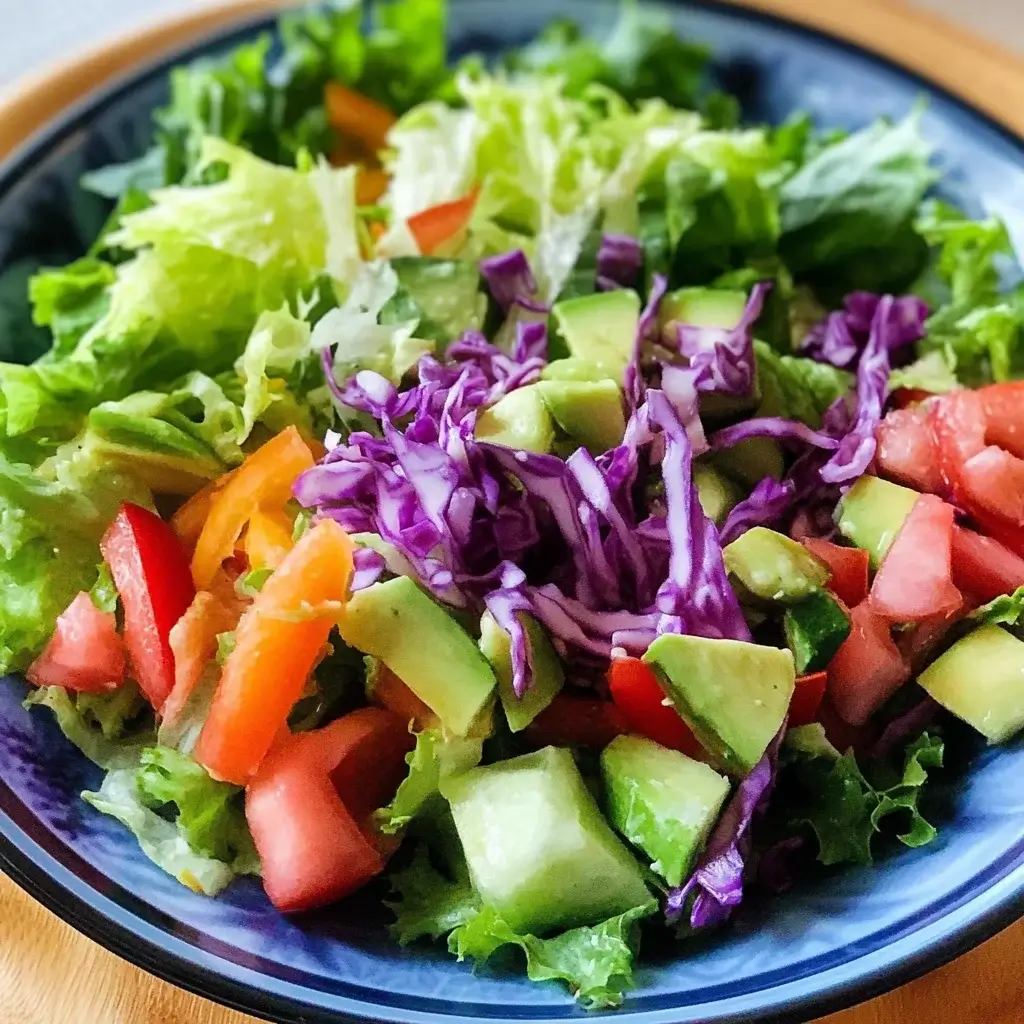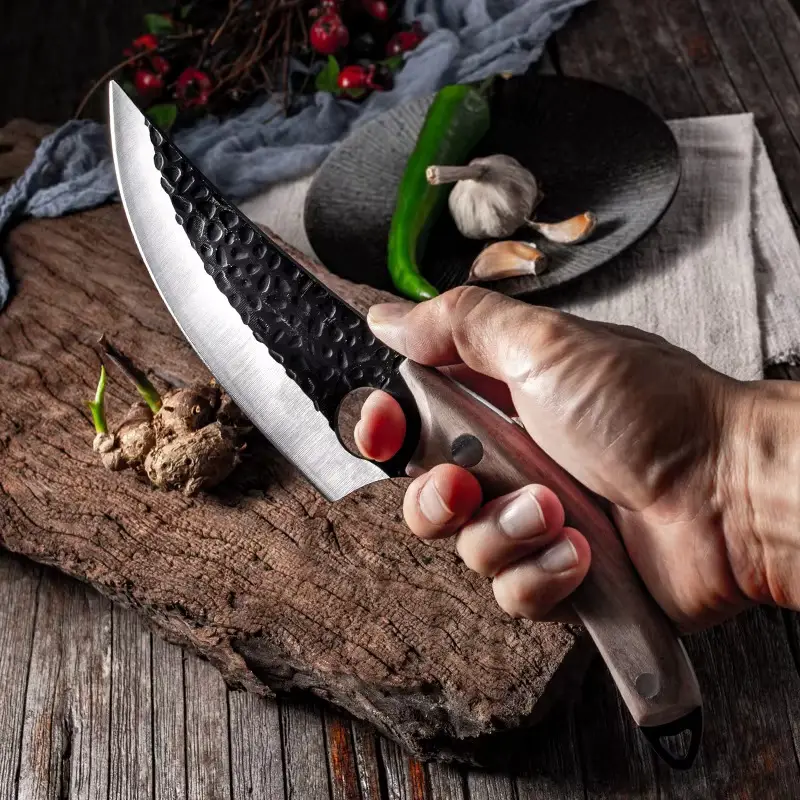It’s funny how some of the simplest dishes can become family favorites, isn’t it? This Fresh Spring Garden Salad, for instance, started as a way to use up the bounty from our little backyard garden. But from the first bite, it was clear this was more than just a salad. The vibrant colors, the crisp textures, and the burst of fresh flavors – it was like spring on a plate! My kids, usually salad skeptics, were actually asking for seconds! Even my husband, a self-proclaimed meat-and-potatoes guy, admitted it was “surprisingly good.” Since then, it’s become a regular feature on our table, especially as the weather warms up. It’s incredibly versatile, too. We’ve served it as a light lunch, a side dish at barbecues, and even topped it with grilled chicken or fish for a complete meal. Honestly, if you’re looking for a salad that’s both healthy and utterly delicious, and truly captures the essence of spring, then you absolutely must try this Fresh Spring Garden Salad. It’s a recipe that’s as joyful to make as it is to eat, and I’m so excited to share it with you.
Ingredients for Fresh Spring Garden Salad
- Mixed Spring Greens (5 oz): A base of tender lettuce varieties like baby spinach, romaine, red leaf, and butter lettuce, providing a light and refreshing foundation for the salad. Look for pre-washed mixes for convenience.
- Asparagus (1 bunch, about 1 pound): Choose firm, bright green asparagus spears. They bring a slightly grassy, earthy flavor and a satisfying crisp-tender texture to the salad.
- Radishes (1 bunch): Select firm, brightly colored radishes. They offer a peppery, slightly spicy bite and a delightful crunch.
- English Cucumber (1 medium): Opt for a firm, seedless English cucumber. Its mild, refreshing flavor and crisp texture complement the other vegetables perfectly.
- Cherry Tomatoes (1 pint): Choose ripe, plump cherry tomatoes. They add sweetness and a juicy burst of flavor. Look for a mix of colors for visual appeal.
- Snap Peas (4 oz): Select bright green, crisp snap peas. They contribute a sweet, crunchy element and a lovely pop of freshness.
- Fresh Dill (1/4 cup, chopped): Fresh dill provides a bright, herbaceous, and slightly citrusy flavor that enhances the spring-like character of the salad.
- Fresh Parsley (1/4 cup, chopped): Fresh parsley adds a clean, slightly peppery, and fresh flavor, complementing the other herbs and vegetables.
- Lemon Vinaigrette Dressing:
- Extra Virgin Olive Oil (1/4 cup): Use high-quality extra virgin olive oil for the best flavor and health benefits. It forms the base of the vinaigrette and adds richness.
- Fresh Lemon Juice (3 tablespoons): Freshly squeezed lemon juice provides acidity and brightness, essential for a vibrant vinaigrette.
- Dijon Mustard (1 teaspoon): Dijon mustard adds a subtle tang and helps emulsify the vinaigrette, creating a smoother texture.
- Honey or Maple Syrup (1 teaspoon): A touch of sweetness balances the acidity of the lemon juice and enhances the overall flavor. Honey or maple syrup are both excellent choices.
- Salt (1/2 teaspoon): Enhances the flavors of all the ingredients and brings the dressing together. Use sea salt or kosher salt.
- Black Pepper (1/4 teaspoon): Freshly ground black pepper adds a subtle spice and depth of flavor to the dressing.
Instructions for Making Fresh Spring Garden Salad
- Prepare the Asparagus: Begin by preparing the asparagus. Wash the asparagus spears thoroughly under cold water. Snap off the tough woody ends of the asparagus stalks – they will naturally break where they become tender. You can also trim the ends with a knife if preferred. Once trimmed, you have several options for cooking the asparagus:
- Blanching (Recommended for vibrant color and texture): Bring a pot of salted water to a rolling boil. Prepare an ice bath by filling a bowl with ice and cold water. Add the asparagus to the boiling water and blanch for 2-3 minutes, until they are bright green and crisp-tender. Immediately transfer the blanched asparagus to the ice bath to stop the cooking process and preserve their color and texture. Once cooled, drain the asparagus and pat them dry with paper towels. Slice the asparagus spears into bite-sized pieces on a bias (diagonally) for visual appeal and easier eating.
- Roasting (For a slightly sweeter, caramelized flavor): Preheat your oven to 400°F (200°C). Toss the asparagus spears with a drizzle of olive oil, salt, and pepper. Spread them in a single layer on a baking sheet. Roast for 8-12 minutes, or until tender-crisp and lightly browned at the tips. Let them cool slightly, then slice into bite-sized pieces.
- Grilling (For a smoky flavor, perfect for BBQs): Preheat your grill to medium heat. Toss the asparagus spears with a drizzle of olive oil, salt, and pepper. Grill for 5-7 minutes, turning occasionally, until tender-crisp and slightly charred. Let them cool slightly, then slice into bite-sized pieces.
- Steaming (For a healthy, low-fat option): Steam the asparagus spears over boiling water for 5-7 minutes, or until tender-crisp. Immediately rinse with cold water to stop cooking. Slice into bite-sized pieces.
- Prepare the Radishes: Wash the radishes thoroughly. Trim off the root end and the leafy tops (you can save the radish greens for another use, like in salads or pesto!). Thinly slice the radishes using a sharp knife or a mandoline for uniform slices. If the radishes are very small, you can halve or quarter them instead of slicing.
- Prepare the Cucumber: Wash the English cucumber. There’s no need to peel English cucumbers as their skin is thin and tender. Slice the cucumber lengthwise, then slice each half into half-moon shapes, about ¼ inch thick.
- Prepare the Cherry Tomatoes: Wash the cherry tomatoes. You can leave them whole if they are small, or halve or quarter them if they are larger, depending on your preference. Halving them will release more of their juices into the salad.
- Prepare the Snap Peas: Wash the snap peas. Trim off the stem end and any stringy parts along the sides of the pods. You can leave them whole or slice them in half lengthwise or diagonally for a different texture and presentation.
- Chop the Fresh Herbs: Rinse the fresh dill and parsley under cold water and pat them dry with paper towels. Finely chop both the dill and parsley using a sharp knife. Set them aside.
- Make the Lemon Vinaigrette Dressing: In a small bowl or a jar, whisk together the extra virgin olive oil, fresh lemon juice, Dijon mustard, honey (or maple syrup), salt, and black pepper. Whisk vigorously until the dressing is well emulsified and slightly thickened. If using a jar, you can simply close the lid tightly and shake well to combine. Taste the dressing and adjust seasonings as needed. You may want to add a little more lemon juice for extra tang, honey for sweetness, or salt and pepper to taste.
- Assemble the Salad: In a large salad bowl, gently combine the mixed spring greens, blanched (or roasted, grilled, or steamed) asparagus, sliced radishes, cucumber slices, cherry tomatoes, and snap peas.
- Dress the Salad: Just before serving, drizzle the lemon vinaigrette dressing over the salad. Start with about two-thirds of the dressing and toss gently to coat all the vegetables evenly. Add more dressing if needed, to your liking. Be careful not to overdress the salad, as it can make it soggy.
- Garnish and Serve: Sprinkle the chopped fresh dill and parsley over the salad. Toss lightly again to distribute the herbs. Serve immediately for the freshest and crispiest salad. If you are not serving immediately, it’s best to keep the dressing separate and dress the salad just before serving to prevent the greens from wilting.
Nutrition Facts for Fresh Spring Garden Salad (per serving)
(Note: Nutritional values are approximate and can vary based on specific ingredients and serving sizes.)
- Serving Size: Approximately 1.5 cups
- Calories: 180-220 kcal
- Total Fat: 15-18g
- Vitamin C: 40-50% DV (Daily Value)
- Vitamin K: 150-200% DV
- Folate (Vitamin B9): 15-20% DV
This Fresh Spring Garden Salad is a nutritional powerhouse, packed with vitamins, minerals, and fiber, while being relatively low in calories and saturated fat. It is a great source of Vitamin C, Vitamin K, and Folate, contributing to overall health and well-being. The healthy fats from olive oil are beneficial for heart health. The fiber content aids in digestion and promotes satiety.
Preparation Time for Fresh Spring Garden Salad
- Prep Time: 20-25 minutes (includes washing, chopping vegetables, and making dressing)
- Cook Time (for blanching/roasting/grilling asparagus): 2-12 minutes (depending on method)
- Total Time: 30-35 minutes
This Fresh Spring Garden Salad is quick and easy to prepare, making it perfect for a weeknight meal or a last-minute side dish. The majority of the time is spent prepping the fresh vegetables, which is a rewarding process in itself, especially when you’re working with such vibrant and beautiful ingredients.
How to Serve Fresh Spring Garden Salad
This versatile Fresh Spring Garden Salad can be served in numerous ways, making it a fantastic addition to any meal or occasion. Here are some ideas:
- As a Light Lunch: Enjoy a generous bowl of this salad on its own for a healthy, refreshing, and satisfying lunch. It’s light yet filling, providing sustained energy without feeling heavy.
- As a Side Dish: Serve it as a vibrant and flavorful side dish alongside grilled chicken, fish, steak, or tofu. It complements richer mains beautifully, adding freshness and balance to the meal.
- With Soup: Pair it with a light soup, such as a chilled cucumber soup, tomato soup, or a creamy vegetable soup, for a complete and balanced lunch or light dinner.
- As a Salad Bar Component: Include it as part of a salad bar spread at gatherings, allowing guests to customize their plates with various dressings and toppings.
- Topped with Protein: Transform it into a more substantial meal by adding protein. Consider topping it with:
- Grilled or Roasted Chicken or Fish: Adds lean protein and heartiness.
- Hard-boiled Eggs: Provides protein and creamy texture.
- Chickpeas or Lentils: For a vegetarian or vegan protein boost.
- Grilled Halloumi or Feta Cheese: Adds salty, savory flavor and protein (vegetarian option).
- Avocado: For healthy fats and creamy texture (vegan and vegetarian).
- For Spring and Summer Gatherings: It’s an ideal salad for spring brunches, Easter celebrations, summer barbecues, picnics, and potlucks. Its fresh flavors and vibrant colors are perfectly suited for warm weather occasions.
- As a Base for Grain Bowls: Use it as a base for grain bowls. Add cooked quinoa, farro, or brown rice to the salad for extra substance and fiber, creating a more filling and nutritious meal.
- With Crusty Bread: Serve alongside crusty bread or baguette slices to soak up the delicious lemon vinaigrette and complete the meal.
Additional Tips for the Best Fresh Spring Garden Salad
To elevate your Fresh Spring Garden Salad and make it even more delicious, consider these helpful tips:
- Use the Freshest Ingredients: The quality of the ingredients is paramount for this salad. Choose the freshest, in-season spring vegetables you can find. Visit your local farmer’s market for the best selection and flavor.
- Don’t Overdress the Salad: Start with less dressing than you think you need and add more gradually, tossing gently after each addition. You want the salad to be lightly coated, not swimming in dressing. Overdressing can make the salad soggy and mask the fresh flavors of the vegetables.
- Dress the Salad Just Before Serving: For optimal crispness and texture, dress the salad right before serving. If you need to prepare it ahead of time, keep the dressing separate and store the salad components in airtight containers in the refrigerator. Dress the salad just before you are ready to eat.
- Chill the Vegetables: For an extra refreshing salad, chill the prepared vegetables (especially the asparagus, radishes, and cucumber) in the refrigerator for about 30 minutes before assembling the salad. This will enhance their crispness and coolness.
- Vary the Vegetables Based on Season and Availability: Feel free to customize the salad based on what’s in season and available to you. Other spring vegetables that would be delicious additions include: fiddleheads (cooked), baby peas, fava beans (shelled and blanched), spring onions, and baby carrots.
- Add Texture and Crunch: Enhance the texture of the salad by adding some crunchy elements. Toasted nuts and seeds like slivered almonds, pine nuts, pecans, sunflower seeds, or pumpkin seeds would be excellent additions. Crispy croutons or even a sprinkle of toasted quinoa can also add a satisfying crunch.
- Experiment with Cheese (Optional): If you are not vegan, consider adding a sprinkle of cheese for extra flavor and creaminess. Crumbled feta cheese, goat cheese, or shaved Parmesan cheese would complement the spring vegetables beautifully. For a dairy-free option, nutritional yeast can add a cheesy, umami flavor.
- Make the Dressing in Advance: The lemon vinaigrette dressing can be made ahead of time and stored in an airtight container in the refrigerator for up to a week. This can save you time when you are ready to assemble the salad. Just be sure to whisk or shake it well before using, as it may separate slightly upon standing.
Frequently Asked Questions (FAQ) about Fresh Spring Garden Salad
Q1: Can I make this salad ahead of time?
A: While it’s best enjoyed fresh, you can prepare the individual components ahead of time. Wash and chop all the vegetables and store them separately in airtight containers in the refrigerator for up to a day. Make the dressing and store it separately as well. Assemble and dress the salad just before serving for the best texture and flavor.
Q2: Can I substitute any of the vegetables?
A: Absolutely! This salad is very versatile. Feel free to substitute vegetables based on your preferences and what’s in season. For example, you can use different types of lettuce, add other spring vegetables like baby peas or fava beans, or swap cherry tomatoes for grape tomatoes or even sliced heirloom tomatoes in the summer.
Q3: Can I make this salad vegan?
A: Yes, this salad is naturally vegan as written! The recipe uses plant-based ingredients and the lemon vinaigrette is vegan-friendly. Just ensure you are using maple syrup or another plant-based sweetener if you are strictly vegan, although most honey is considered vegan-friendly by many.
Q4: How long does the salad last once dressed?
A: It’s best to consume the salad immediately after dressing for optimal crispness. Once dressed, the greens will start to wilt, and the vegetables may lose some of their crunch. If you have leftovers, store them undressed in an airtight container in the refrigerator and dress them fresh when you are ready to eat.
Q5: Can I add protein to make it a main course salad?
A: Yes, definitely! Adding protein is a great way to make this salad a more substantial meal. Grilled chicken, fish, shrimp, tofu, chickpeas, lentils, hard-boiled eggs, or grilled halloumi cheese are all excellent protein additions that would pair well with the fresh spring flavors.
Q6: What if I don’t have fresh dill or parsley? Can I use dried herbs?
A: Fresh herbs are recommended for the best flavor in this salad, as they provide a brighter and more vibrant taste. However, if you don’t have fresh dill or parsley, you can use dried dill and parsley in a pinch. Use about 1/3 of the amount of dried herbs compared to fresh herbs (e.g., if the recipe calls for ¼ cup fresh dill, use about 1 tablespoon of dried dill). Keep in mind that the flavor will be less intense and nuanced.
Q7: Can I use a different type of dressing?
A: Yes, you can certainly experiment with different dressings. While the lemon vinaigrette complements the spring vegetables beautifully, other dressings that would work well include a balsamic vinaigrette, a creamy avocado dressing, a poppy seed dressing, or a light honey mustard vinaigrette. Choose a dressing that you enjoy and that complements the fresh flavors of the salad.
Q8: Is this salad gluten-free?
A: Yes, this Fresh Spring Garden Salad is naturally gluten-free, as it is made with vegetables, herbs, olive oil, lemon juice, and seasonings, none of which contain gluten. Always double-check ingredient labels if you are using pre-made ingredients or adding toppings to ensure they are also gluten-free if necessary for your dietary needs.
Print
Fresh Spring Garden Salad
Ingredients
- Mixed Spring Greens (5 oz): A base of tender lettuce varieties like baby spinach, romaine, red leaf, and butter lettuce, providing a light and refreshing foundation for the salad. Look for pre-washed mixes for convenience.
- Asparagus (1 bunch, about 1 pound): Choose firm, bright green asparagus spears. They bring a slightly grassy, earthy flavor and a satisfying crisp-tender texture to the salad.
- Radishes (1 bunch): Select firm, brightly colored radishes. They offer a peppery, slightly spicy bite and a delightful crunch.
- English Cucumber (1 medium): Opt for a firm, seedless English cucumber. Its mild, refreshing flavor and crisp texture complement the other vegetables perfectly.
- Cherry Tomatoes (1 pint): Choose ripe, plump cherry tomatoes. They add sweetness and a juicy burst of flavor. Look for a mix of colors for visual appeal.
- Snap Peas (4 oz): Select bright green, crisp snap peas. They contribute a sweet, crunchy element and a lovely pop of freshness.
- Fresh Dill (1/4 cup, chopped): Fresh dill provides a bright, herbaceous, and slightly citrusy flavor that enhances the spring-like character of the salad.
- Fresh Parsley (1/4 cup, chopped): Fresh parsley adds a clean, slightly peppery, and fresh flavor, complementing the other herbs and vegetables.
- Lemon Vinaigrette Dressing:
- Extra Virgin Olive Oil (1/4 cup): Use high-quality extra virgin olive oil for the best flavor and health benefits. It forms the base of the vinaigrette and adds richness.
- Fresh Lemon Juice (3 tablespoons): Freshly squeezed lemon juice provides acidity and brightness, essential for a vibrant vinaigrette.
- Dijon Mustard (1 teaspoon): Dijon mustard adds a subtle tang and helps emulsify the vinaigrette, creating a smoother texture.
- Honey or Maple Syrup (1 teaspoon): A touch of sweetness balances the acidity of the lemon juice and enhances the overall flavor. Honey or maple syrup are both excellent choices.
- Salt (1/2 teaspoon): Enhances the flavors of all the ingredients and brings the dressing together. Use sea salt or kosher salt.
- Black Pepper (1/4 teaspoon): Freshly ground black pepper adds a subtle spice and depth of flavor to the dressing.
Instructions
- Prepare the Asparagus: Begin by preparing the asparagus. Wash the asparagus spears thoroughly under cold water. Snap off the tough woody ends of the asparagus stalks – they will naturally break where they become tender. You can also trim the ends with a knife if preferred. Once trimmed, you have several options for cooking the asparagus:
- Blanching (Recommended for vibrant color and texture): Bring a pot of salted water to a rolling boil. Prepare an ice bath by filling a bowl with ice and cold water. Add the asparagus to the boiling water and blanch for 2-3 minutes, until they are bright green and crisp-tender. Immediately transfer the blanched asparagus to the ice bath to stop the cooking process and preserve their color and texture. Once cooled, drain the asparagus and pat them dry with paper towels. Slice the asparagus spears into bite-sized pieces on a bias (diagonally) for visual appeal and easier eating.
- Roasting (For a slightly sweeter, caramelized flavor): Preheat your oven to 400°F (200°C). Toss the asparagus spears with a drizzle of olive oil, salt, and pepper. Spread them in a single layer on a baking sheet. Roast for 8-12 minutes, or until tender-crisp and lightly browned at the tips. Let them cool slightly, then slice into bite-sized pieces.
- Grilling (For a smoky flavor, perfect for BBQs): Preheat your grill to medium heat. Toss the asparagus spears with a drizzle of olive oil, salt, and pepper. Grill for 5-7 minutes, turning occasionally, until tender-crisp and slightly charred. Let them cool slightly, then slice into bite-sized pieces.
- Steaming (For a healthy, low-fat option): Steam the asparagus spears over boiling water for 5-7 minutes, or until tender-crisp. Immediately rinse with cold water to stop cooking. Slice into bite-sized pieces.
- Prepare the Radishes: Wash the radishes thoroughly. Trim off the root end and the leafy tops (you can save the radish greens for another use, like in salads or pesto!). Thinly slice the radishes using a sharp knife or a mandoline for uniform slices. If the radishes are very small, you can halve or quarter them instead of slicing.
- Prepare the Cucumber: Wash the English cucumber. There’s no need to peel English cucumbers as their skin is thin and tender. Slice the cucumber lengthwise, then slice each half into half-moon shapes, about ¼ inch thick.
- Prepare the Cherry Tomatoes: Wash the cherry tomatoes. You can leave them whole if they are small, or halve or quarter them if they are larger, depending on your preference. Halving them will release more of their juices into the salad.
- Prepare the Snap Peas: Wash the snap peas. Trim off the stem end and any stringy parts along the sides of the pods. You can leave them whole or slice them in half lengthwise or diagonally for a different texture and presentation.
- Chop the Fresh Herbs: Rinse the fresh dill and parsley under cold water and pat them dry with paper towels. Finely chop both the dill and parsley using a sharp knife. Set them aside.
- Make the Lemon Vinaigrette Dressing: In a small bowl or a jar, whisk together the extra virgin olive oil, fresh lemon juice, Dijon mustard, honey (or maple syrup), salt, and black pepper. Whisk vigorously until the dressing is well emulsified and slightly thickened. If using a jar, you can simply close the lid tightly and shake well to combine. Taste the dressing and adjust seasonings as needed. You may want to add a little more lemon juice for extra tang, honey for sweetness, or salt and pepper to taste.
- Assemble the Salad: In a large salad bowl, gently combine the mixed spring greens, blanched (or roasted, grilled, or steamed) asparagus, sliced radishes, cucumber slices, cherry tomatoes, and snap peas.
- Dress the Salad: Just before serving, drizzle the lemon vinaigrette dressing over the salad. Start with about two-thirds of the dressing and toss gently to coat all the vegetables evenly. Add more dressing if needed, to your liking. Be careful not to overdress the salad, as it can make it soggy.
- Garnish and Serve: Sprinkle the chopped fresh dill and parsley over the salad. Toss lightly again to distribute the herbs. Serve immediately for the freshest and crispiest salad. If you are not serving immediately, it’s best to keep the dressing separate and dress the salad just before serving to prevent the greens from wilting.
Nutrition
- Serving Size: one normal portion
- Calories: 220
- Fat: 18g






